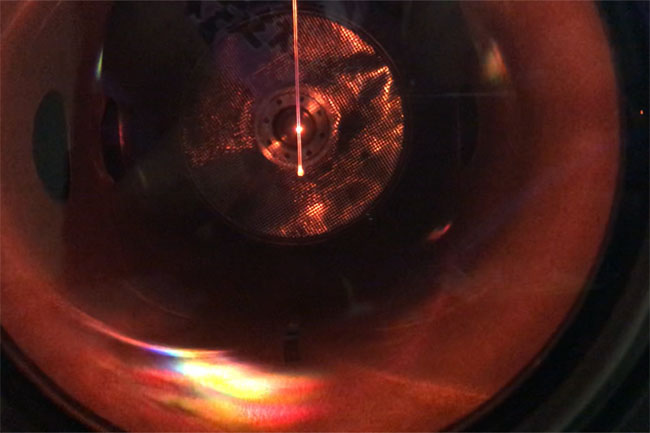Researchers at the University of Central Florida (UCF) have shown that industrial-grade lasers can be used to generate attosecond pulses.
“One of the main challenges of attosecond science is that it relies on world-class laser facilities,” professor Michael Chini said. The ability to use industrial-grade lasers, instead of complex systems that require large laboratory facilities and cleanroom environments, could make attosecond scientific techniques more accessible to researchers from all disciplines.
To produce the extremely short light pulses needed for attosecond research, laser light is propagated through tubes filled with noble gases, such as xenon or argon, to further compress the pulses in time. The UCF team showed that nonlinear compression could be efficient when driven in molecular gases, using pulses substantially longer than a few cycles, because nonlinearity is enhanced. The enhanced optical nonlinearity is associated with rotational alignment.

A laser light shines in a gas cell where UCF researchers generate attosecond pulses. Courtesy of the University of Central Florida (UCF).
The UCF researchers compressed approximately 100-cycle pulses from industrial-grade lasers by using molecular gases such as nitrous oxide in the tubes instead of noble gases and by varying the length of the pulses they sent through the gas.
They demonstrated that 80-cycle pulses from an industrial-grade laser amplifier could simultaneously drive molecular alignment and supercontinuum generation in a gas-filled capillary. This produced more than two octaves of coherent bandwidth and achieved a greater than forty-fivefold compression to a duration of 1.6 cycles.
The researchers believe that single-cycle pulses are within reach with this technique.
“We show that industrial-grade lasers, which can be purchased commercially from dozens of vendors with a price tag of around $100,000, can now be used to generate attosecond pulses,” Chini said.
The choice of gas and duration of the pulses are key, researcher John Beetar said. “If the tube is filled with a molecular gas, and in particular a gas of linear molecules, there can be an enhanced effect due to the tendency of the molecules to align with the laser field."
“However, this alignment-caused enhancement is only present if the pulses are long enough to both induce the rotational alignment and experience the effect caused by it,” Beetar said. “The choice of gas is important since the rotational alignment time is dependent on the inertia of the molecule, and to maximize the enhancement we want this to coincide with the duration of our laser pulses.”
The setup is simple and can work with a wide variety of lasers with different parameters, Chini said.
Attosecond science works in a way similar to sonar or 3D laser mapping, but at a much smaller scale. When an attosecond light pulse passes through a material, the interaction with electrons in the material distorts the pulse. Measuring these distortions allows researchers to construct images of the electrons and make movies of their motion. The ability to make measurements with attosecond precision allows researchers to study the fast motion of electrons inside atoms and molecules at their natural timescale.
Measuring this fast motion can help researchers better understand how light interacts with matter, which can inform efforts to harvest solar energy, detect chemical and biological weapons, and perform medical diagnostics. Use of a commercial, industrial-grade laser could make attosecond science more accessible and could enable interdisciplinary applications by scientists with little to no laser background.
The research was published in Science Advances (www.doi.org/10.1126/sciadv.abb5375).